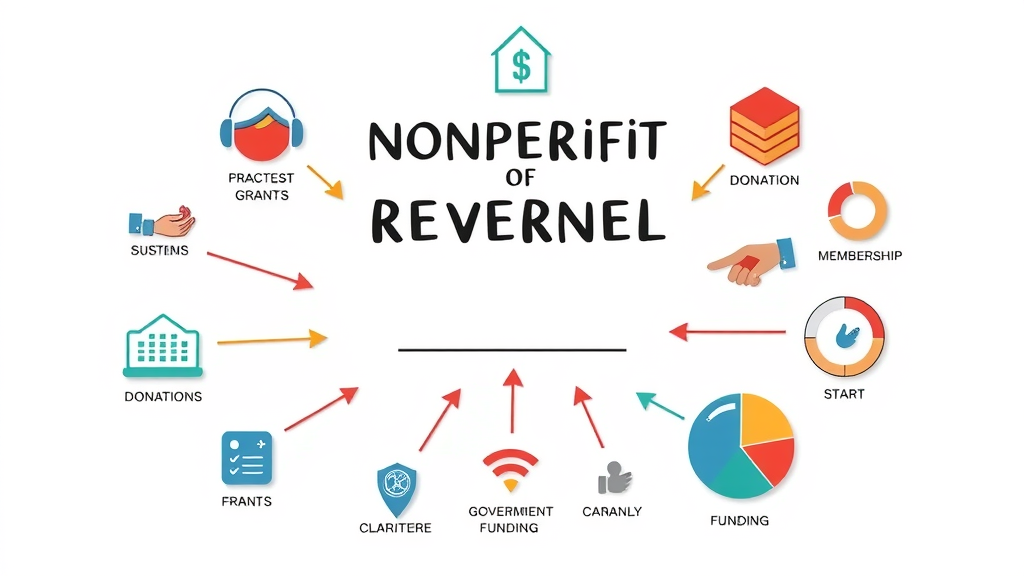Did you know that over 30% of nonprofits operate close to breakeven? It’s a startling fact that highlights how many organizations struggle to maintain steady financial footing. That’s why discovering reliable nonprofit budgeting strategies isn’t just important—it's essential for survival. This comprehensive guide reveals the building blocks of a powerful budget, lays out proven tactics, and showcases the tools you need to master your organization’s financial health swiftly.
Startling Facts About Nonprofit Budgeting Strategies
"According to the National Center for Charitable Statistics, over 30% of nonprofits operate close to breakeven, underlining the need for robust nonprofit budgeting strategies."

Managing a nonprofit budget can feel overwhelming, especially with limited resources and high expectations from stakeholders. The pressure to meet program goals while maintaining fiscal responsibility requires savvy planning. Financial hiccups—whether from overestimating revenue sources or underestimating operating expenses—can threaten even established organizations. By sharpening your approach to nonprofit budgeting, you can ensure your mission continues to thrive well past this fiscal year.
What You'll Learn About Nonprofit Budgeting Strategies
- Core principles of nonprofit budgeting strategies
- How to develop a comprehensive nonprofit budget
- Key elements to include for accuracy and transparency
- Best practices in resource allocation and sustainability
- Proven templates and tools for nonprofit budgeting
- Common pitfalls in nonprofit budgets and how to avoid them
Understanding Nonprofit Budgeting Strategies
Why Effective Nonprofit Budgeting Strategies Matter

Effective nonprofit budgeting strategies are the backbone of a successful organization. They provide a roadmap for allocating resources, ensuring every dollar advances your mission and meets regulatory requirements. With a solid operating budget, nonprofit leaders can track line items, predict cash flow, and make data-driven decisions that maximize long-term impact. Robust financial management helps bridge multiple funding streams and assures donors that their contributions are spent wisely, which directly supports your nonprofit financial health and builds stakeholder trust.
Without disciplined budgeting processes, it’s easy to lose sight of the big picture. This can lead to underfunded programs, unchecked overhead costs, and surprises during the fiscal year. By focusing on the main building blocks—predicting revenue and expenses, setting annual budgets, and reviewing financial reports regularly—organizations stay agile and mission-focused. Ultimately, investing time in strong nonprofit budgeting procedures pays dividends in transparency, accountability, and organizational resilience.
Difference Between a Nonprofit Budget and For-Profit Budget
While both nonprofit and for-profit organizations depend on strategic budgeting, their approaches differ significantly. A nonprofit budget prioritizes mission-driven results, allocating resources to programs that create social impact rather than generate profit. Revenue sources for nonprofits may include grants, donations, memberships, and government funding, which can fluctuate from year to year. In contrast, for-profit budgets focus on profit generation and investor returns, often relying on predictable revenue streams from products or services.
Another key difference lies in how organizations report and manage overhead costs. Nonprofits must balance overhead—such as administrative, fundraising, and personnel costs—with program expenses to demonstrate efficiency to stakeholders. For-profit budgets, meanwhile, cater to maximizing shareholder value. Nonprofit budgets also emphasize transparency and compliance, as misallocation of resources can erode public trust. By understanding these distinctions, you can tailor your nonprofit budgeting strategies to prioritize both impact and sustainability.
Key Components of a Successful Nonprofit Budget
Operating Budget: The Backbone of Nonprofit Budgeting Strategies
An operating budget is the cornerstone of any nonprofit budgeting strategy. It outlines all the predicted revenue and expenses for a fiscal year, typically broken down by line items and categories. This detailed approach ensures each department, program, or project receives the necessary funds to meet objectives while keeping the entire organization on track. Regularly reviewing your operating budget as a living document allows for dynamic adjustments throughout the budgeting process.
Your operating budget should include personnel costs, direct program expenses, overhead costs, and a reserve for contingencies. By capturing every cost and revenue stream, you can avoid unpleasant surprises and ensure resources are used efficiently. Establishing realistic projections and involving key stakeholders in the process further improves accuracy and ensures the budget reflects your mission and strategic goals.
Revenue Sources in Nonprofit Budgeting Strategies

Diversifying revenue sources is a hallmark of resilient nonprofit budgeting. Key revenue streams typically include grants, fundraising campaigns, individual donations, corporate philanthropy, membership dues, and sometimes government funding. Understanding the nuances of each source is crucial: grants often come with restrictions, donations can fluctuate with economic shifts, and events demand upfront investments with uncertain returns.
Tracking each revenue stream as an individual line item enables better forecasting and safeguards your organization against financial shortfalls. By developing a robust system for monitoring and analyzing revenue sources, you strengthen your ability to respond to market changes and donor preferences. Routine reporting not only supports internal financial management but also demonstrates transparency and accountability to external stakeholders and donors.
Allocating Resources to Maximize Impact
Learning to effectively allocate resources lies at the heart of nonprofit budgeting. Your goal should be to deploy funds so that each dollar delivers maximum impact—whether through direct services, outreach initiatives, or critical infrastructure. Start by aligning allocations with your organizational priorities and strategic plan. Consider the proportional split between program services, overhead costs, and fundraising, as this balance communicates your organization’s values to stakeholders and funders.
Budget transparency helps build credibility with donors and the public. Each allocation should be tied to clear outcomes and regularly evaluated against program performance. This ongoing review enables you to re-route funds where they’re most needed, adapt to shifting demands, and mitigate risks. Leveraging technology and regular financial reports streamlines this process, fostering strategic decision-making and sustainable growth for your nonprofit.
| Category | Description | Example Line Items |
|---|---|---|
| Operating Budget | Annual budget for core operations and programs | Personnel costs, rent, supplies, outreach |
| Revenue Sources | Various funding streams | Grants, donations, government funding, memberships |
| Administrative Costs | Overhead expenses for running the organization | Utilities, accounting, legal, insurance |
| Program Expenses | Direct costs related to mission delivery | Materials, travel, event costs, training |
How to Create a Nonprofit Budget: Step-by-Step Guide
Gathering Financial Data for Nonprofit Budgeting
The first stage in developing your nonprofit budget involves collecting thorough and accurate financial data. Begin by reviewing prior years’ financial reports, noting all revenue sources and expense patterns. Analyze your past line items to identify any gaps in funding or unexpected costs that arose during the previous fiscal year. Accurate historical data forms the foundation for credible budget projections and can reveal hidden trends impacting your organization’s financial health.
Engage your team—especially those responsible for program leadership and financial management—in this data-gathering process. Assign responsibilities for gathering current invoices, receipts, grant documentation, and donor history. Request feedback on anticipated new expenses or potential increases in operating costs. The more comprehensive and transparent your data collection, the better your nonprofit budget will reflect reality, setting you up for a smoother fiscal year ahead.
Using a Nonprofit Budget Template for Efficiency
Implementing a nonprofit budget template streamlines your budgeting process and reduces the risk of oversight. These preformatted tools prompt your team to consider all necessary income and expense categories, from program costs to overhead, and even smaller line items such as supplies or travel. Templates foster consistency across fiscal years, simplify the approval process for the board, and ensure clarity when sharing budget details with stakeholders or external auditors.
Choose a template that is flexible enough to accommodate the unique aspects of your organization. Look for features like automatic calculations, customizable line items, and clear visual breakdowns to enhance both accuracy and understanding. Using a proven budget template speeds up the preparation phase, allows for easier updates throughout the year, and acts as a living document supporting the larger nonprofit financial management process.
Analyzing and Projecting Revenue and Expenses

To create a realistic nonprofit budget, you must accurately analyze and project both revenue and expenses for the upcoming fiscal year. Start by examining all current and potential revenue sources, such as grants, direct donations, and event income. Be conservative with projections to avoid overestimating your financial position—unexpected changes can quickly undermine your cash flow and operating budget.
Next, map out all expected expenses, separating them into direct program costs, administrative overhead, and reserves for contingencies. Take special care with personnel costs, often the largest line item in nonprofit budgets. By collaborating across departments, you can spot hidden expenses and ensure full coverage for all organizational needs. Finally, build in regular checkpoints throughout the year to compare actual performance with your projections, making timely adjustments as necessary.
Monitoring, Adjusting, and Improving Nonprofit Budgets
A budget isn’t set in stone—it should be reviewed and updated regularly to reflect actual financial performance and shifting organizational priorities. Schedule monthly or quarterly budget check-ins, comparing forecasted revenue and expenses to what your financial reports show. This ongoing monitoring allows your nonprofit to respond swiftly to shortfalls, seize new opportunities, or reallocate resources as new challenges arise.
Establish clear communication channels throughout your budgeting process, involving program managers, finance staff, and leadership. Encourage input from all stakeholders to ensure the budget remains aligned with your mission. Periodic reviews and updates turn your annual budget into a dynamic tool for strategy, not just compliance. In doing so, you ensure your nonprofit budgeting strategies remain effective, transparent, and focused on your organizational goals.
Winning Nonprofit Budgeting Strategies in Action
- Incremental Budgeting: Adjusts previous budgets by adding or subtracting for known changes.
- Zero-Based Budgeting: Builds each line item from zero, requiring full justification for all expenses.
- Scenario Planning: Creates budgets for multiple possible financial situations (best, worst, most likely).
- Collaborative Budgeting Process: Engages multiple stakeholders to ensure buy-in and accuracy.
- Leveraging Technology Tools: Uses digital platforms for efficiency, transparency, and secure recordkeeping.
"Adopting digital tools boosted our transparency and donor trust, reshaping our approach to nonprofit budgeting strategies." – Successful Nonprofit Leader
Essential Nonprofit Budget Templates and Tools
Recommended Nonprofit Budget Template for Quick Implementation

Choose a nonprofit budget template that’s easy to understand and tailor to your needs. Many templates include columns for predicted and actual revenue, detailed expense line items, and space for notes on variances. Templates should be downloadable (Excel, Google Sheets) and support uploads into your accounting or nonprofit financial management software. This helps bridge multiple departments and ensures all stakeholders remain up-to-date with financial status in real time.
Key features to look for in a budget template include automatic subtotaling, percentage-of-budget calculations, and dedicated rows for in-kind donations and restricted funds. Using such a tool not only enhances financial strategy and transparency but also simplifies the reporting process to boards, auditors, and funders. As a living document, a great template is the first step to mastering ongoing nonprofit budgeting strategies.
Top Digital Tools for Streamlining Nonprofit Budgets
Modern nonprofit budgeting relies heavily on accessible, cloud-based digital tools. Popular solutions like QuickBooks Nonprofit, Sage Intacct, and Excel with built-in nonprofit budgeting templates can automate calculations, facilitate collaborative editing, and enhance data security. Many platforms provide dashboards for tracking cash flow, revenue and expenses in real time, or running custom reports to suit your nonprofit organization’s needs.
When selecting a platform, prioritize integration with your donor management and grant-tracking systems. Features like automated alerts for overages, customizable line items, scenario analysis, and board-ready financial reports can free up valuable staff time and reduce errors. Leveraging digital tools is no longer optional—it’s the foundation for efficient, transparent, and sustainable nonprofit financial management.
| Tool/Template | Best For | Key Features | Integration |
|---|---|---|---|
| Excel Nonprofit Budget Template | Small to medium nonprofits | Customizable, free, offline access | Manual or with accounting software |
| QuickBooks Nonprofit | Medium to large nonprofits | Fund tracking, automated reporting, multi-user | Connects with donor CRMs |
| Sage Intacct | Multi-location nonprofits | Cloud-based, robust analytics, permission control | High-level integrations |
| Google Sheets Template | Startups and remote teams | Collaboration, real-time updates, free | Online; exportable to Excel |
Common Mistakes to Avoid in Nonprofit Budgeting Strategies
- Overestimating revenue
- Underestimating expenses
- Skipping contingency planning
- Ignoring stakeholder input
- Not reviewing nonprofit budgets regularly

It’s easy to fall into these traps when developing your nonprofit budget—being too optimistic about fundraising goals, overlooking minor line items, or skipping input from key team members. Poor contingency planning can leave you unprepared for unexpected expenses or revenue shortfalls. Regular, honest reviews are critical to keeping your nonprofit organization agile and sustainable. By proactively addressing these common errors, you’ll build a stronger, more resilient operating budget.
Answers to Frequently Asked Questions about Nonprofit Budgeting Strategies
- What is a nonprofit budget and why is it important?
- A nonprofit budget is a plan that forecasts all expected revenue and expenses for a fiscal year. It is important because it guides allocation of resources, ensures transparency, helps track progress toward goals, and demonstrates responsible stewardship to donors and regulators.
- How do you create an effective nonprofit budget template?
- Start by listing all sources of revenue and categories of expenses as line items. Use historical data to inform projections, and select a template that offers flexibility, clarity, and easy integration with existing financial management tools. Regular updates and stakeholder input are essential.
- What are the main sources of revenue for nonprofit budgets?
- Main revenue sources include grants, donations, memberships, fundraising events, and sometimes government contracts or program fees. Diversifying these revenue streams increases sustainability and resilience.
- How often should nonprofit organizations review their budgets?
- Regular review—monthly or quarterly—is recommended. Frequent check-ins help catch discrepancies early, adapt to changes in cash flow, and keep the organization aligned with its strategic objectives.
People Also Ask About Nonprofit Budgeting Strategies
What makes a great nonprofit budget?
A great nonprofit budget is detailed, realistic, and closely aligned to the organization's mission and strategy. It includes well-researched estimates for both revenue and expenses, allocates resources efficiently, and incorporates input from key stakeholders. Most importantly, it remains flexible and is regularly reviewed for ongoing improvement.
What is the best method for allocating resources in nonprofit budgeting strategies?
The best method combines data analysis with participatory decision-making. By gathering program data, conducting cost–benefit analyses, and inviting input from staff and leadership, organizations ensure funds are directed where they’ll have the greatest impact. Strategic use of digital tools also streamlines this process and increases transparency.
How do nonprofit budgeting strategies impact overall organizational success?
Strategic budgeting directly influences an organization's stability, growth, and reputation. Well-planned nonprofit budgets enable sustainable programs, build donor trust, and reduce risk, while poorly executed strategies can lead to missed opportunities and reputational harm. Robust budgets set the stage for long-term success.
Are budget templates necessary for every nonprofit organization?
While small nonprofits may start with informal budgeting, templates provide consistency and thoroughness even for lean teams. They help standardize the process, minimize errors, and ensure no aspect of the budget is overlooked. For transparency and accountability, templates are invaluable tools for every organization.
Key Takeaways: Master Nonprofit Budgeting Strategies
- Strategic nonprofit budgeting ensures organizational stability
- Comprehensive budgeting strategies foster trust and transparency
- Leveraging templates and tools enhances efficiency and accuracy
Conclusion: Take Action to Strengthen Your Nonprofit Budgeting Strategies Today
Don’t wait—start refining your nonprofit budgeting strategies now. For personalized, expert help, call me the Chaplain 786-333-5270.
"Start your nonprofit budgeting transformation now. For tailored guidance, call me the Chaplain 786-333-5270."
To further enhance your understanding of effective nonprofit budgeting strategies, consider exploring the following resources:
- “How do nonprofits develop and manage budgets?” (us.fundsforngos.org)
This article offers best practices for nonprofit budgeting, including collaborative budgeting for enhanced buy-in, ongoing financial review for adaptability, and empowering staff through financial literacy.
- “Budgeting Strategies for Nonprofit Organizations” (ngoconnectsa.org)
This resource provides insights into developing program-based budgets, diversifying revenue sources, and prioritizing core expenses to maximize impact.
By delving into these materials, you’ll gain practical insights and strategies to strengthen your organization’s financial health and sustainability.
 Add Row
Add Row  Add
Add 




Write A Comment